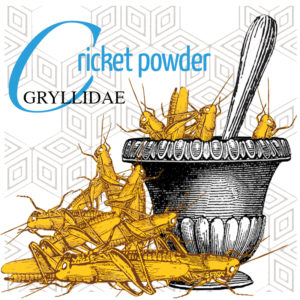 Cricket protein is considered a new protein trend yet it’s one of the oldest. Humans have been eating insects for a very long time. It has only recently been considered “icky”.
Cricket protein is considered a new protein trend yet it’s one of the oldest. Humans have been eating insects for a very long time. It has only recently been considered “icky”.
It’s also only a regional disgust. The U.S., Canada and Europe are the exceptions rather than the rule. Most of the world eats insects. Even our southern neighbor, Mexico, enjoys almost 200 different types of bugs in their daily meals.
There are many reasons to use cricket powder as a protein source. These include health and nutrition but also the environment and social reasons, as outlined below.
Cricket protein is a highly nutritious food source that is rich in protein, prebiotic fiber, vitamins, minerals, and healthy fats. It’s very bio-available (in other words – cricket powder is easily digested).
Cricket protein contains all of the essential amino acids (see chart below). It’s packed with B vitamins Magnesium, as well as a perfect balance of Omega 3:6 (over 5x that of salmon). In addition, crickets have more calcium than milk and more iron than spinach. There are even more health benefits.
Check Out: Insect Nutrition Information
The cricket’s chitin (exoskeleton) is prebiotic fiber, just to top it off. Prebiotics are nutrition for probiotics. So, if you’re taking probiotics, it’s a good idea to add prebiotics to your routine. Even if you are not taking probiotics, prebiotics from cricket powder will promote a healthy gut biome.
When you use cricket powder or eat insects whole, you are eating the whole animal. Heart, lungs, everything. Meat is generally muscle and that is all we eat of most livestock. But, with insects, we are eating the whole bug and that is one of the reasons they are so nutritious. Crazy as it sounds, by eating the brains, heart, lungs, and the rest of the cricket parts not normally thought of as “meat” it’s giving us a wider variety of nutrients.
Cricket Protein is also Healthy for the Planet
Cricket protein is not only healthy for us, but it’s also sustainable and produced without growth hormones, pesticides, or herbicides. It’s non-GMO and can be produced organic and gluten-free depending upon the methods used.
Crickets can be grown using way less land, food, and water than traditional livestock making them a planet-friendly practice. They are raised and harvested humanely.
Cricket Protein is also Healthy for Society
Crickets are grown by families in their home, by small independent farms and also by large industrial operations. The availability of insect protein makes it an important factor in food security. Yet, many overlook this resource.
But, there is a serious issue we need to resolve. Our view of insects as a survival food and the food of the poor have shamed people worldwide into giving up traditional foods that use insects. The younger generation, worldwide, prefers beef, especially steak, over traditional foods.
A nutritious high protein food source that’s affordable and available to almost anyone anywhere being abandoned because we look down on it.
You can help. Start conversations and post online about your edible insect culinary experiences. If we make it a trend here, people worldwide will react. Traditional foods will become popular once again.
Below you can check out the nutritional values for 100 grams of cricket powder.
NUTRITIONAL VALUES
Analyzed by Maxxam Analytics
Energy 1973kJ (472kCal)
Protein (g) 58.76
Fat (g) 24
Saturated Fat (g) 8.48
Trans Fat (g) .218
Cholesterol (mg) 228
Carbohydrates (g) 8.4
Fiber, total dietary (g) 6.0
Sugars (g) 0.5
Ash (g) 6.5
Calcium (g) 0.11
Iron (g) 0.002
Potassium (g) 1.1
Sodium (g) 0.31
Omega – 3 (g) 2.81
Omega – 6 (g) 6.28
Saturate Fatty Acids (g) 8.48
Cis-Monounsaturated (g) 5.14
Cis-Polyunsaturated (g) 9.09
B-12 (ug) 24
Essential Amino Acid Profile per 100g of Crickets (*BCAAs)
1.44g – Histidine
2.59g – Isoleucine*
4.61g – Leucine*
3.61g – Lysine
1.09g – Methionine
0.51g – Cysteine
2.37g – Threonine
0.56g – Tryptophan
3.70g – Valine
Environmental Impact of Cricket vs. Beef
Grow 10x Faster
Drink 1000x Less Water
Consume 5x Less Feed
Require 1000x Less Land
Emit 100x Fewer Greenhouse Gases

Good for You | Good for Our Planet






